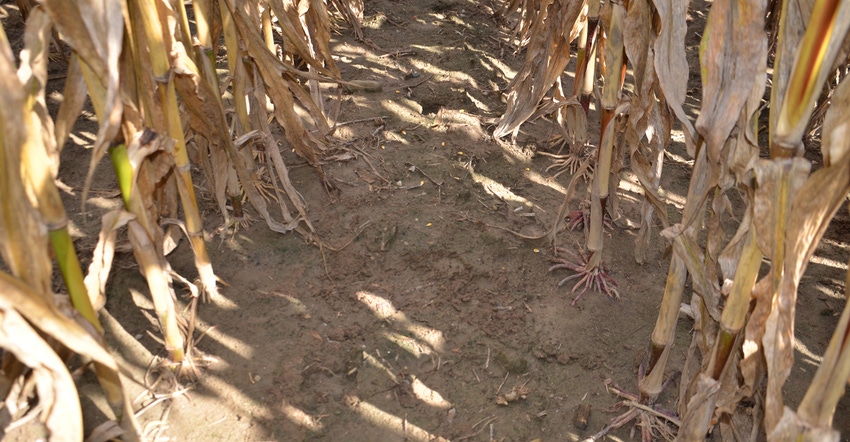
Earlier in the season, Dave Nanda pointed out multiple differences in characteristics between the two hybrids that were planted in the Corn Watch ’18 field. They included plant height, ear height, days to tasseling and silking, number of branches per tassel, rows of kernels per ear and kernels per row on each ear, and much more. He made those types of observations all the way to harvest.
“You owe it to yourself to learn as much as you can about the hybrids you have in your lineup,” Nanda says. “A great way to do that is to study carefully how they look growing in your own fields. When you have them side by side, it’s very easy to see visual differences.”
Nanda, a former plant breeder, is an independent crop consultant based in Indianapolis. He made regular visits to the Corn Watch ’18 field this year. Corn Watch ’18 is sponsored by Seed Genetics-Direct, Washington Court House, Ohio.
Brace roots
Differences in the two hybrids were obvious because the operator planted strips of 24 rows of each one across the entire field. Nanda found breaks where the two hybrids were side by side and made comparisons at various places within the field.
He also points out that decades ago, plant breeders talked about things such as plant height and ear placement as traits, but today they more often refer to such things as characteristics. That’s because when most people hear the word “trait” today, they think of GMO traits such as Bt protection for corn borer or rootworm. The word “trait” was adopted by the technology companies.
One characteristic that differed between the hybrids and was easy to spot just before harvest, as leaves dried up, was the size of brace roots. One hybrid consistently had larger brace roots that were more obvious located at the soil line.
“It’s one of the characteristics a plant breeder takes notes on,” Nanda says. “It’s usually a positive characteristic. If you can have larger brace roots and still have all the other things you need, including high yield potential, you would prefer to breed for larger brace roots.”
In other words, everything else being equal, strong brace roots are a plus, Nanda continues. They offer the plant more stability as an anchor in the soil. That becomes important when windy conditions that could create lodging occur. Of course, some storms are so severe that all plants will succumb, regardless of how much root strength they possess.
The ability to produce a large root mass below the surface is also critical, Nanda says. This can vary among hybrids as well.
Should you select one hybrid over another just because it has better brace roots? Of course not, Nanda says. Hybrids with preferable traits must also excel in yield potential.
“The point is that you need to pay attention to other characteristics besides just yield,” he concludes. “It may be important when you’re deciding where to place various hybrids on your farm.”
About the Author(s)
You May Also Like




